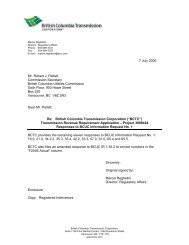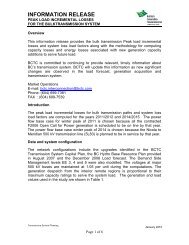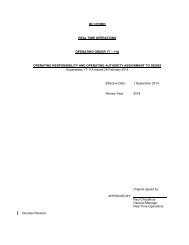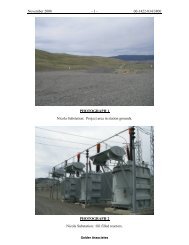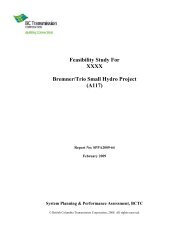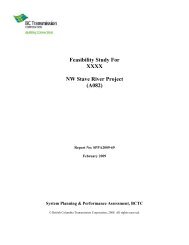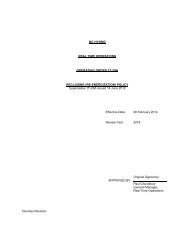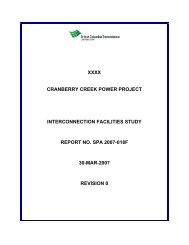Evidence on the Adequacy of First Nations Consultation - BC Hydro ...
Evidence on the Adequacy of First Nations Consultation - BC Hydro ...
Evidence on the Adequacy of First Nations Consultation - BC Hydro ...
You also want an ePaper? Increase the reach of your titles
YUMPU automatically turns print PDFs into web optimized ePapers that Google loves.
c<strong>on</strong>cerning <strong>the</strong> identificati<strong>on</strong> <strong>of</strong> <strong>the</strong>se more recent cultural heritage resources. One examinati<strong>on</strong>,<br />
c<strong>on</strong>sisting <strong>of</strong> field work carried out by Paul Snead and his team in 1978 14 in resp<strong>on</strong>se to a proposal to<br />
divert <strong>the</strong> Kootenay River into <strong>the</strong> Columbia for power generati<strong>on</strong> purposes, stated [pp. 51-52]:<br />
…test excavati<strong>on</strong>s at <strong>the</strong> nor<strong>the</strong>ast end <strong>of</strong> Windermere Lake (McKenzie, 1975), Fairm<strong>on</strong>t Hot Springs<br />
(Choquette, 1971) and several o<strong>the</strong>r localities, have not revealed c<strong>on</strong>clusive evidence <strong>of</strong> use as<br />
habitati<strong>on</strong>s. According to Borden, "a test excavati<strong>on</strong> just bey<strong>on</strong>d <strong>the</strong> lip <strong>of</strong> a large house pit (sic) at site<br />
EcPx-2...yielded no artifacts, but much ash, fire cracked rocks, and numerous splintered animal b<strong>on</strong>es"<br />
(Borden, 1956: 81). Reexaminati<strong>on</strong> <strong>of</strong> site EcPx-2 by this study team revealed no large house pit. In<br />
fact, as menti<strong>on</strong>ed before, many <strong>of</strong> <strong>the</strong> so-called house pits, previously recorded by o<strong>the</strong>r investigators<br />
are natural features. Fur<strong>the</strong>rmore, we believe that most, if not all, <strong>of</strong> <strong>the</strong>se large features were not used<br />
as habitati<strong>on</strong>s but ra<strong>the</strong>r as large storage or food processing facilities.<br />
C<strong>on</strong>cerning <strong>the</strong>ir attributi<strong>on</strong> to Shuswap people, he more generally c<strong>on</strong>cludes [p. 58]<br />
Al<strong>on</strong>g with earlier investigators, we observed that <strong>the</strong> two major classes <strong>of</strong> projectile points were small<br />
side-notched and triangular varieties and, generally larger stemmed and corner-notched varieties. In his<br />
earlier investigati<strong>on</strong>s, Borden assigned <strong>the</strong> small side-notched points to <strong>the</strong> Salishan Shuswap and<br />
c<strong>on</strong>sidered <strong>on</strong>ly <strong>the</strong> larger corner-notched arrow points to be associated with <strong>the</strong> Kootenay Indians<br />
(1956: 97). However, research by o<strong>the</strong>rs (Choquette, 1971; and, Taylor, 1973) and our own<br />
observati<strong>on</strong>s <strong>of</strong> artifact distributi<strong>on</strong>s indicate that this associati<strong>on</strong> is <strong>on</strong>ly partially correct, at best. The<br />
Kootenay, also, made and used small triangular side-notched projectile points.<br />
Features, such as <strong>the</strong> supposed housepits, exhibited <strong>on</strong> heritage sites in <strong>the</strong> Upper Columbia valley have<br />
also been used to assign cultural identity and chr<strong>on</strong>ology (Borden, 1956). However, we believe this can<br />
be tentative, at best. Features like food processing facilities are known to occur in both Shuswap and<br />
Ktunaxa settlement patterns. Storage pits, although thought to be more closely associated with <strong>the</strong><br />
Shuswap, cannot be definitely assigned to <strong>the</strong>m al<strong>on</strong>e. Finally, <strong>the</strong> large circular depressi<strong>on</strong>s, thought<br />
to be Shuswap housepits, as we have argued earlier, may not even be habitati<strong>on</strong> features.<br />
Snead’s team found evidence <strong>of</strong> c<strong>on</strong>siderable pre-historic and proto-historic activity in <strong>the</strong> Upper<br />
Columbia Valley. In <strong>the</strong>ir Phase I rec<strong>on</strong>naissance, <strong>the</strong>y discovered 180 heritage sites and reevaluated<br />
51 more, c<strong>on</strong>cluding that <strong>on</strong>ly 13 were attributable to “historic Euro-canadian<br />
col<strong>on</strong>izati<strong>on</strong>”. The study projected from its representative sampling that “<strong>the</strong>re would be about 238<br />
heritage sites in <strong>the</strong> potential impact z<strong>on</strong>e which is over 100 linear miles l<strong>on</strong>g and 250 to 1000 feet<br />
wide” [p. viii]. Almost 90% <strong>of</strong> <strong>the</strong>se aboriginal sites were classified as close to <strong>the</strong> high water line <strong>of</strong><br />
<strong>the</strong> Columbia [p. 65]. The area distributi<strong>on</strong> <strong>of</strong> all aboriginal sites, indicating that almost half may be<br />
in or near <strong>the</strong> CVT study area, was given as follows [p. ix]:<br />
119 (55%) are recorded in <strong>the</strong> area from Canal Flats to Invermere (Secti<strong>on</strong> 1), 93 (42%) are recorded in<br />
<strong>the</strong> area from Invermere to Spillimacheen (Sector 2), and 6 (3%) are found in <strong>the</strong> area from<br />
Spillimacheen to Golden (Sector 3).<br />
The Snead report cautiously c<strong>on</strong>cludes that from at least <strong>the</strong> middle <strong>of</strong> <strong>the</strong> Late Prehistoric Period (ca.<br />
A.D. 500-1800) “<strong>the</strong>re is evidence <strong>of</strong> substantial occupati<strong>on</strong>, probably by ancestral Kootenay<br />
speakers, in <strong>the</strong> Upper Kootenay River valley and, by extensi<strong>on</strong>, probably in <strong>the</strong> Upper Columbia<br />
River Valley."<br />
Although <strong>the</strong>y are most famously thought <strong>of</strong> as passing over <strong>the</strong> Rockies to hunt buffalo, <strong>the</strong> Upper<br />
Ktunaxa regularly travelled westward over <strong>the</strong> mountains too. For example, Choquette observed 15 :<br />
14 Snead, Paul G., Kootenay River Diversi<strong>on</strong> - Cultural Heritage Resources, Phase I Impact Statement, January 1978<br />
10<br />
Page 154 <strong>of</strong> 200






